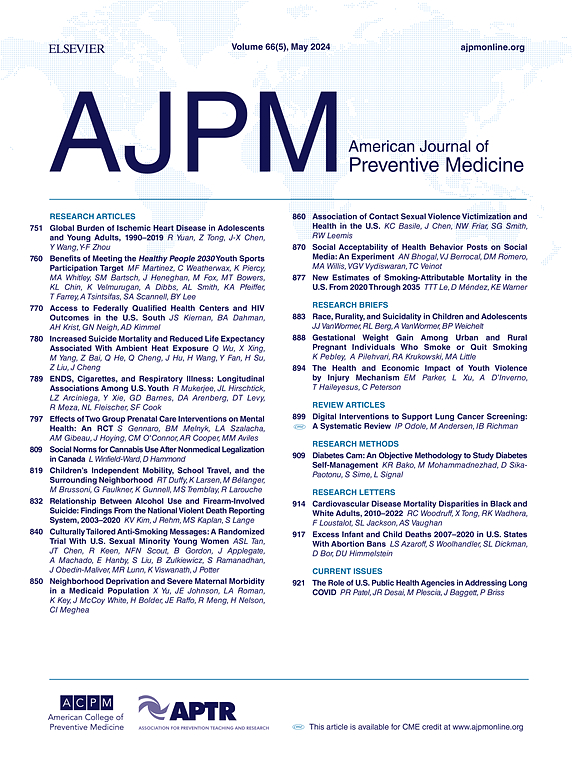美国休闲大麻零售商的不平等地理分布
IF 4.3
2区 医学
Q1 MEDICINE, GENERAL & INTERNAL
引用次数: 0
摘要
导读:尽管美国越来越多的州继续将成人娱乐用大麻的销售合法化,但人们对大麻零售商的空间分布与社区特征的关系知之甚少。本研究的目的是检查人口普查区大麻零售商的存在与否与邻里优势和劣势的衡量标准有关。方法:利用2023个美国州机构名单,我们在18个有娱乐性大麻合法化法律的州确定了5586家娱乐性大麻零售商和地理编码地址数据。采用多水平logistic和负二项回归方法,对社区剥夺指数(NDI)和极端浓度指数(ICE)的五分位数与人口普密区大麻零售商存在之间的关系进行了建模。结果:在研究的各州中,11%的人口普查区至少有一家休闲大麻零售商。人口普查区的社会经济剥夺程度较高,或种族化和经济劣势较大,拥有大麻零售商的几率和比例明显更高。在调整后的分析中,低收入黑人或西班牙裔居民最集中的地区,大麻零售商存在的几率是优势地区的2.0至2.5倍。结论:在非医用大麻合法化的州,存在一种模式,即大麻零售商存在于社区最不利的地区。公共卫生机构和决策者应支持实施减少大麻零售商聚集的政策,并在历史上处于不利地位的地区加强有针对性的预防工作。本文章由计算机程序翻译,如有差异,请以英文原文为准。
The Unequal Geography of Recreational Cannabis Retailers in the U.S.
Introduction
Although more U.S. states continue to legalize the sale of cannabis for recreational adult-use, little is known about the spatial distribution of cannabis retailers in relation to neighborhood characteristics. The objective of this study is to examine the presence or absence of cannabis retailers in census tracts in relation to measures of neighborhood advantage and disadvantage.
Methods
Using 2023 U.S. state agency lists, we identified 5,586 recreational cannabis retailers and geocoded address data in 18 states with recreational cannabis legalization laws. Multilevel logistic and negative binomial regression were used to model the association between quintiles of the neighborhood deprivation index and index of concentration at the extremes with census tract cannabis retailer presence.
Results
Across the study states, 11% of census tracts had at least 1 recreational cannabis retailer. Census tracts with higher levels of socioeconomic deprivation, or racialized and economic disadvantage, had a significantly higher odds and rate of having cannabis retailers. In the adjusted analysis, tracts with the greatest concentration of low-income Black or Hispanic residents had 2.0–2.5 times the odds of cannabis retailer presence compared to more advantaged tracts.
Conclusions
In states with legalized nonmedical cannabis, there is a pattern of greater cannabis retailer presence in areas with the greatest neighborhood disadvantage. Public health agencies and policymakers should support the implementation of policies that reduce cannabis retailer clustering and enhance targeted prevention efforts in historically disadvantaged areas.
求助全文
通过发布文献求助,成功后即可免费获取论文全文。
去求助
来源期刊

American Journal of Preventive Medicine
医学-公共卫生、环境卫生与职业卫生
CiteScore
8.60
自引率
1.80%
发文量
395
审稿时长
32 days
期刊介绍:
The American Journal of Preventive Medicine is the official journal of the American College of Preventive Medicine and the Association for Prevention Teaching and Research. It publishes articles in the areas of prevention research, teaching, practice and policy. Original research is published on interventions aimed at the prevention of chronic and acute disease and the promotion of individual and community health.
Of particular emphasis are papers that address the primary and secondary prevention of important clinical, behavioral and public health issues such as injury and violence, infectious disease, women''s health, smoking, sedentary behaviors and physical activity, nutrition, diabetes, obesity, and substance use disorders. Papers also address educational initiatives aimed at improving the ability of health professionals to provide effective clinical prevention and public health services. Papers on health services research pertinent to prevention and public health are also published. The journal also publishes official policy statements from the two co-sponsoring organizations, review articles, media reviews, and editorials. Finally, the journal periodically publishes supplements and special theme issues devoted to areas of current interest to the prevention community.
 求助内容:
求助内容: 应助结果提醒方式:
应助结果提醒方式:


